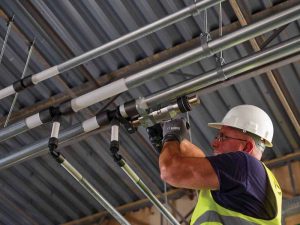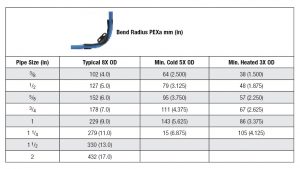
Many commercial buildings require plumbing systems to be installed within return air plenums or fire-rated assemblies.
When placing PEX in a plenum, design professionals use ASTM E84, Standard Test Method for Surface Burning Characteristics of Building Materials, to evaluate whether materials will help spread a fire or create smoke when burned. Individual PEX manufacturers obtain their listings and certifications for plenum applications using different installation methods such as half-inch fiberglass insulation or galvanized support channels.
Underwriters Laboratories (UL)-listings are required when combustible material is installed in fire-rated assemblies, such as reinforced concrete slabs, wood-framed floor/ceiling assemblies, and framed bearing and nonbearing walls.
Since all potable water in the United States is disinfected using chlorine, all PEX tubing must be tested and certified by qualified third-party certification agencies to meet the requirements of ASTM F876, Standard Specification for Crosslinked Polyethylene (PEX) Tubing, including chlorine resistance.
“PEX pipe has shown itself to be resistant to attack from chlorine and chloramines under a wide range of conditions, and has performed reliably in all regions of North America,” the ICC said in its design guide (read Design Guide: Residential PEX Water Supply Plumbing Systems, Second Edition, [November 2013] from the Plastic Pipe and Fittings Association [PPFA]/International Code Council [ICC]/Plastics Pipe Institute [PPI]/Home Innovation Research Labs).

Plumbing professionals must also consider ultraviolet (UV) resistance when specifying PEX tubing for commercial plumbing. Most PEX has some UV resistance, but prolonged exposure to direct or indirect sunlight can damage the tubing. PEX should not be stored outdoors or used in outdoor applications unless buried in the ground or protected in some other way.
It is advisable to check with the manufacturer to find out the maximum recommended UV exposure time limit of the PEX, based on the UV resistance (read Design Guide: Residential PEX Water Supply Plumbing Systems, Second Edition, [November 2013] from the Plastic Pipe and Fittings Association [PPFA]/International Code Council [ICC]/Plastics Pipe Institute [PPI]/Home Innovation Research Labs).
Installation considerations
When installing PEX tubing, proper support spacing must be observed per code. PEX expands and contracts when heated and cooled, so it is important to keep this in mind when designing and specifying pathways and supports. It is recommended to choose supports that will not cut, scratch, or damage the tubing.
Standard CTS hangers can be used to support suspended sections of PEX tubing. Fixed support points will hold PEX in place and minimize the movement of the tubing during expansion or contraction, thus mitigating any damage to the pipe. Isolating suspension clamps allow the tubing to slide within the support.
To increase the spacing between support hangers, specifying engineers can choose galvanized steel support channels, into which the PEX tubing is placed. These support channels also minimize expansion and contraction that occurs when the tubing is heated and cooled.
Designers and specifiers must consider an approved through-penetration firestop system when PEX tubing will penetrate floors, ceilings, and walls. The most common firestop system standards are ASTM E814, Fire Tests of Through-Penetration Firestops, and UL 1479, Fire Tests of Through-Penetration Firestops. It is important to ensure the firestop system meets all local code requirements before installation.
Incorporating proper controls into the PEX plumbing system is crucial, as failure to follow pressure and temperature limits may damage the tubing, resulting in leaks and possible breakdown of the system. The maximum temperature and pressure ratings of PEX plumbing systems are in accordance with ASTM F876 and PPI TR-3, Policies and Procedures for Developing Hydrostatic Design Basis, Hydrostatic Design Stresses, Pressure Design Basis, Strength Design Basis, Minimum Required Strength Ratings and Categorized Required Strength for Thermoplastic Piping Materials or Pipe.




